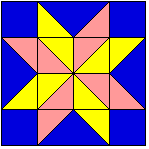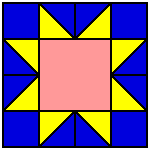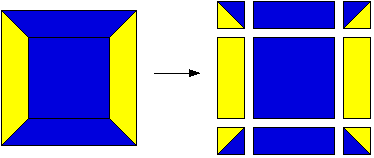
When I was in high school I was a square who liked to play with triangles. I took advanced algebra and geometry because I enjoyed them. I never figured any of that stuff would actually apply to my real life. And then I came to quilting! But I avoided triangles as much as possible because I never could quite figure out how to make the points sharp. And figuring out how to draft a block with triangles in it made me bleary eyed. But then I saw the relation my math background had with the creation of simple triangles. There really are tried and true formulas to figure out those pesky triangle measurements with a very accurate yield. This lesson will cover two of the most common triangles quilters use and then show you some tips and tricks in how to use these triangles to conquer some fairly pesky blocks. (Anything with a set in seam qualifies as a pesky block with me.)
The two most common triangles are the right triangle and the equilateral triangle. The right triangle has two of its three sides perpendicular to each other, thereby forming a 90 degree angle. The bottom (base) is perpendicular to its height (leg). The equilateral triangle is one in which all the sides are equal in length.

A half-square triangle is half of a square. Cut a square 7/8" larger than the finished size of the square unit. For example, for a 4" finished square, cut 2 squares of fabric 4-7/8"

Draw a diagonal line on the wrong side of the lighter fabric. Place squares right sides together and sew 1/4" on both sides of the drawn line. Cut along this line. Press toward the darker fabric. Yields 2 half-square triangle squares which are 4" finished.

A quarter-square triangle is one fourth of a square. Cut a square of fabric 1-1/4" larger than the finished size of the square unit. For example, for a 4" finished square, cut 2 squares of fabric 5-1/4". This will yield two quarter-square triangle units.

Draw diagonal lines on the wrong side of the lighter fabric. Either cut along these lines and sew contrasting triangles together along one short side or place squares right sides together and sew 1/4" on both sides of both lines. Cut along the drawn lines. Press toward the darker fabric. Yields two quarter-square triangle blocks/units.

This block is composed of three triangles. The larger triangle is a half square triangle. The two smaller triangles are two units from a quarter-square triangle block. Use the formulas described above to determine cutting sizes.

Why struggle with set-in seams when you can convert this to an easy piecing dream? Draw imaginary lines so that you see the half-square triangles. Use the half-square triangle formula to construct your LeMoyne Star as indicated above.

An Ohio Star is based on a 16 grid. If the finished block is 12" then each unit is 3" square. The star points can be made using the half-square triangle method.

The Spool Block is simply constructed using rectangles, half square triangles, and a larger central square. What could be easier?
This method of using half-square and quarter-square triangles is a simpler way to approach other blocks, too. Consider using this technique to piece the Attic Window block and also to make Flying Geese. There are endless possibilities to your creativity when you no longer fear the math involved in those pesky triangles.
Back to Quilting Lessons page